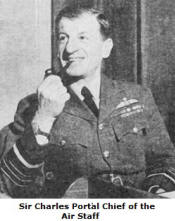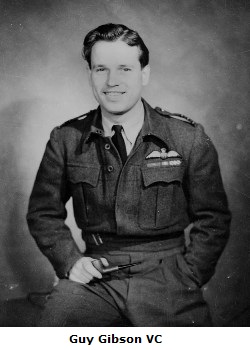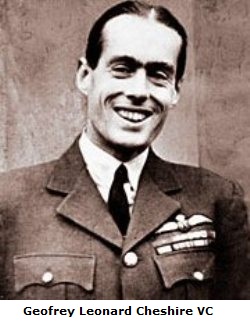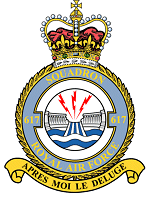|
 When
he was initially told of Barnes Wallis' plans to breaching the
Ruhr Dams, Sir Arthur Harris described the plans as "tripe of
the wildest description. There are so many ifs & that
there is not the smallest chance of it working".
However, when overruled by the Chief of the Air Staff Sir
Charles Portal. Harris ordered Sir Ralph Cochrane AOC in C
of 5 Group to form a special squadron to carry out the
operation.
The squadron was formed at Group Captain Charles
Whitworth’s main base
at RAF Scampton on 21 March 1943 under the command of
Wing Commander Guy Gibson. Apart
from United Kingdom personnel, the squadron had a strong Commonwealth
contingent from Canada, Australia and New Zealand. When
he was initially told of Barnes Wallis' plans to breaching the
Ruhr Dams, Sir Arthur Harris described the plans as "tripe of
the wildest description. There are so many ifs & that
there is not the smallest chance of it working".
However, when overruled by the Chief of the Air Staff Sir
Charles Portal. Harris ordered Sir Ralph Cochrane AOC in C
of 5 Group to form a special squadron to carry out the
operation.
The squadron was formed at Group Captain Charles
Whitworth’s main base
at RAF Scampton on 21 March 1943 under the command of
Wing Commander Guy Gibson. Apart
from United Kingdom personnel, the squadron had a strong Commonwealth
contingent from Canada, Australia and New Zealand.
The squadron was formed specifically to attack the Ruhr Dams.
After the operation, 34 of the survivors were decorated,
Guy Gibson,
receiving the Victoria Cross.
The Squadron's badge, approved by King George VI, depicts the bursting
of a dam, in commemoration of
Chastise. The motto
Après moi le deluge roughly translated means
"After me, the flood”.
When Gibson was posted away from 617 Squadron he was
succeeded by Wing Commander George
Holden, who was killed in an expensive and
unsuccessful attack on the Dortmund Ems canal,
together with four of Guy Gibson’s original crew.
Harold. "Micky" Martin took temporary command, before Leonard Cheshire
took over as CO. Cheshire devised
and
personally took part in the special target marking techniques
that went far beyond the standard of the Pathfinder squadrons
who were responsible to marking targets for typical main force
attacks.
|
|

Cheshire experimented with a number of aircraft in the target
marking role including the Mosquito and the Mustang.
Cheshire was an exceptional leader. His citation for
the Victoria Cross noted that: "In four years of fighting
against the bitterest opposition he maintained a standard of
outstanding personal achievement, his successful operations
being the result of careful planning, brilliant execution and
supreme contempt for danger – for example, on one occasion he
flew his P-51 Mustang in slow 'figures of eight' above a target
obscured by low cloud, to act as a bomb-aiming mark for his
squadron. Cheshire displayed the courage and determination of an
exceptional leader" It also noted a raid in which he had
marked a target, flying a Mosquito at low level against
"withering fire"..
One of Cheshire's notable operations was against the Gnome-Rhone
aero engine factory at Limoges, 200 miles southwest of Paris.
At the factory Cheshire made three low passes over the factory
to alert the French workers and give them time to take cover.
On his fourth pass his bomb aimer marked the exact centre of the
factory. Photo reconnaissance the following day showed
that half of the forty-eight bays were flattened and the rest
were shells.
Throughout the rest of the war, the Squadron continued the specialist
and precision bombing role, including the use of the
12,000
"Tallboy" and
22,000
"Grand Slam" ground-penetrating earthquake bombs, on targets such as
concrete U-boat shelters and bridges, and the Dortmund-Ems Canal was
finally breached with Tallboys in September 1944.
On July 1944, Wing Commander J B Tait took over as CO.
|
|

Under Tait's command, the squadron bombed a series of V-1 storage
sites and V-2 launching sites using Barnes Wallis's "Tallboy"
12,000 lb deep penetration bomb. Tait was awarded a bar to his
DFC for pressing home a low-level attack in a daylight raid on
the Kembs Dam in southern Germany against fierce defensive fire
despite having a damaged aircraft.
On
12th November 1944 Tait led a force of Lancasters from Numbers 9
and 617 Squadron for the third and final attack on the Trpitz.
Three direct hits left the ship capsizd west of Tromso in the
bay of Håkøybotn.
In total the squadron carried out 1,599 operational sorties at a
cost of 32 aircraft and 204 men
In December 1944, Wing Commander John Fauquier succeeded Tait as
CO. Under his command the Dambusters conducted raids
against submarine pens, viaducts and other targets.
At the war's end,
the squadron was given the Avro Lincoln, following those in 1952
with the English Electric Canberra jet bomber. The squadron was
deployed to Malaya for four months in 1955, returning to RAF Binbrook
to be disbanded on 15 December 1955
Reformed at RAF Scampton on 1 May 1958 as part of
RAF Bomber Command's V-bomber force maintaining the UK's strategic
nuclear deterrent, the squadron was equipped with the Avro Vulcan B1
from Aug 1960.
By 23 May 1961 its aircraft were the
upgraded Vulcan B1A
fitted with the ECM tailpod. The squadron's
assigned role was high-level strategic bombing with a variety of free
fall nuclear bombs. Both the B1 and B1A types were equipped with various
free-fall nuclear weapons.
These
may have included
Blue Danube,
Red Beard, Violet Club the Interim Megaton Weapon, Yellow Sun
Mk.1, and certainly Yellow Sun Mk2.

In
January 1970 the squadron's eight Vulcan B2 aircraft were re-equipped
with the new strategic laydown bomb, WE.177B which improved
aircraft survivability by enabling aircraft to remain at low-level
during
weapon release. The
squadron's Vulcan B2s served mainly in that low-level penetration role
until disbandment on 31 December 1981.
The
squadron reformed on 1 January 1983 at RAF Marham re-equipped with
twelve Tornado GR1 armed with
WE.177 nuclear bombs, and the squadron's role assigned remained one of support for land forces on the Continent.
In
1993 617 Squadron began to changeover to the ant-shipping role
and by 1994 was stationed at
RAF Lossiemouth assigned to SACLANT with the Tornado GR4B with
the Sea Eagle missile. 617 Sqn also routinely deployed in
support Operation Resinate and Operation Bolton, the RAF
contribution to Operation Southern Watch, the last time being in
the spring and summer of 2000 to Ali Al Salem Air Base, Kuwait.
617 Sqn continued its
pioneering heritage by becoming the first RAF squadron to fire
the
MBDA
Storm Shadow cruise-missile, during
the
2003 invasion of Iraq.
|
